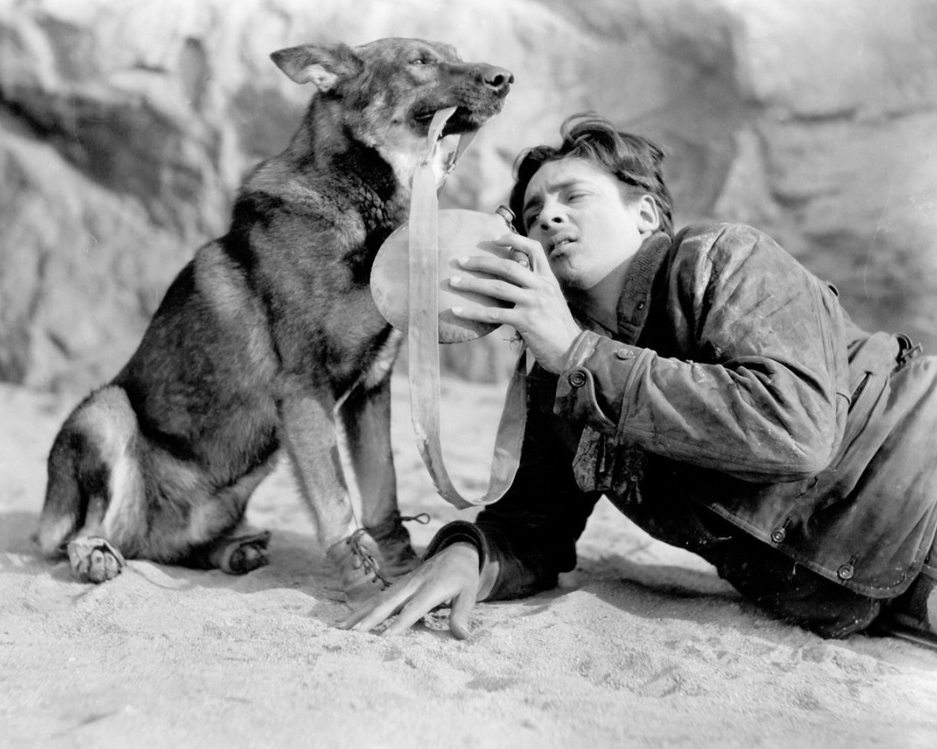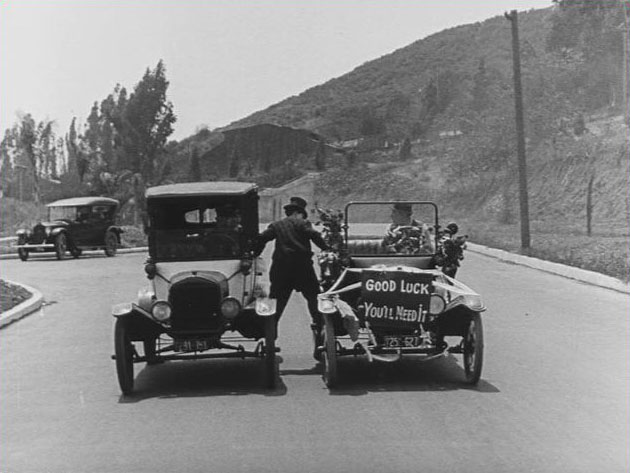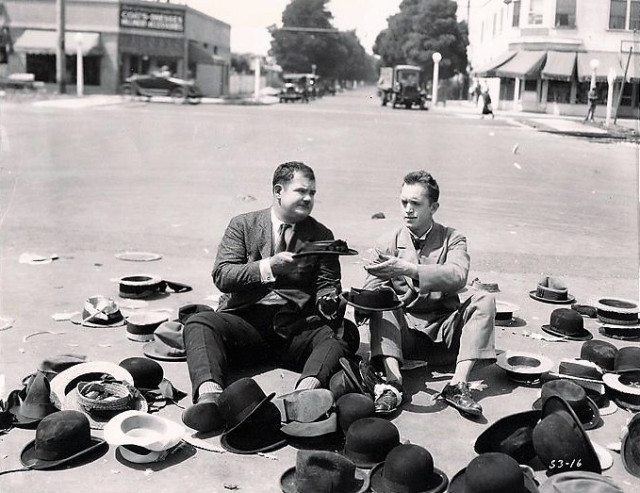
An interview with the Renaissance Man of silent film
Ben Model
by Phil Bailey
To put it bluntly, Ben Model loves silent movies. He is a silent film historian and a live music accompanist for films at the Museum of Modern Art (NYC) and the Library of Congress Packard Campus Theatre (Culpeper, Virginia) as well as a performer at theaters, festivals, and schools across the country. He recently performed a live score for the Rin Tin Tin classic Clash of the Wolves at the TCM Classic Film Festival. Model is also the founder of Undercrank Productions, the organization keeping the torch burning for silent film preservation with the release of lesser-known films, presented in their best possible versions with high-quality music scores. In his free time, he hosts The Silent Comedy Watch Party, airing on YouTube every Sunday. Started on a lark with co-host Steve Massa, the watch party is still going strong three years later.
When it comes to the silents, Ben Model’s passion and enthusiasm are apparent and highly contagious. He does a masterful job of demystifying the century-old films to allow their magic to captivate new audiences in the 21st Century. With the 10th anniversary of the founding of Undercrank Productions looming, Ben and I got together to talk about his journey making a career out of silent movies, the effect the audience has on his scoring, the challenges of running a small video label, and the one film he would love to see return from the ashes.
• •
Phil Bailey: As a way of introducing yourself, how did you get into silent film? It’s not commonplace anymore.
Ben Model: No, not anymore. I discovered it when I was a kid. In the 1960s, silent comedy shorts were shown as kids’ programming on the independent stations, or as filler for prime time series on public television in the ’70s, like The Silent Years (1971), so it was not super hard to find silent comedy films. My folks tell me I discovered Charlie Chaplin as a toddler. It was one of those things where I don’t really remember not being into silent movies.
Phil: So what was the next step? How did you get into being a historian? Did that happen by accident?
Ben: Yeah, the historian part just sort of gradually grew out of what I was doing with silent film. I saw silent movies on television, or by saving up paper route and lawn-mowing money and buying Super 8 copies of things. I also had a unique situation where… I don’t know if you’re familiar with the book, The Silent Clowns, by Walter Kerr?
Phil: Yes.
Ben: Okay, so Walter Kerr was the drama critic for the New York Times and he lived in my town out in Westchester County in New York State, and my folks remembered hearing that he had a huge film collection. I wrote him a letter when I was 12 after I got the book, and he called me a few days later.
And so, for the next 15-20 years, a bunch of times a year, I’d go over to his house and he would just say, “What do you want to see?” because he had 16 millimeter prints of things you just couldn’t get.
At the same time, I was taking piano lessons as one does, and the two things collided when I went to film school. I was a film production major in film history classes, and because this was before home video, they showed the silent films in dead silence. And my second year of school there, I don’t know why, but I came up with the idea of trying to play for the films on piano, and that’s how I got started with that.
I met people who were accompanying films in New York City, including a guy named Lee Erwin, who was a movie organist in the 1920s. Just getting to see a lot of these films by being booked to accompany them helped feed my interest. I was seeing and playing for films that had been just titles in a book for me, so the historian, in particular, grew out of that. I made a shift away from trying to be a comedy writer and comedian and filmmaker, and silent film just sort of worked out.
Phil: How many times do you watch a film while you’re developing your score for it?
Ben: Usually once. The scores that I perform are largely improvised. Although I may have some themes worked out ahead of time, and if a piece of music is deliberately referenced, I have to make sure I have the music for it, I just need to look at it once. I take a lot of story notes that I’ll have in front of me, so that’ll help me anticipate what’s coming up, what’s coming up later, if there are any surprise moments or sudden shifts. I can write a note to myself that lists the two or three things that happen before: the irate father bursts through the door or there’s an explosion. I can musically support the anticipation, build toward it, instead of doing something that’s so on the money it brings attention to the score or missing it entirely, by being late. If I’m playing for The General or Safety Last or The Mark of Zorro, I don’t really need to make notes. These films are now old friends of mine. You can hit me on the head with a 2 x 4 and I’d still be able to play for them. I’d have to wipe the blood off the keys, but I could still play for them.
Phil: Since you improvise a lot, does the audience affect your score?
Ben: Oh yeah. I’m definitely aware of the audience and maybe listening not only for an audible response, but for something we film accompanists develop, this sixth sense of understanding what the vibe in the room is like. You can tell when an audience has clicked in, and about four or five minutes into the film you just know, okay, they’re there.
Like when I was playing for Clash of the Wolves, the Rin Tin Tin film, at the TCM Festival, Jacqueline Stewart introduced the film, and she had a great expression for this. She said it’s kind of like call and response. It’s not an audible thing all the time, but there is this level of interaction between me and the film, but also between me and the audience, and then there’s the audience and the film, and there’s a Venn diagram where all three of these things overlap. It was probably one of the most enthusiastic audiences for silent film I’ve experienced. In the first shot of Rin Tin Tin, I got an applause break. I thought, okay, they’re on the ride, they’re on the roller coaster, this is going to be fine.

Phil: And I’m sure it’s always better when they’re in the groove, than when they’re not.
Ben: Oh yeah, a bunch of fourth graders watching Buster Keaton’s One Week is just… one of the reasons I show it is there’s a moment early on in the film, when even if you’re 16 and sitting in the back with your arms folded, when Keaton is straddling the two running boards of the two cars then gets hit by that motorcycle, you can’t help but laugh, and it gives everyone in the room permission. “Okay, this is funny. I can enjoy the rest of the picture.” So yeah. You’re absolutely right. When I can tell they’re on the ride, I know I don’t need to help them as much as I might for another kind of an audience. Like my students, when I have nine college students in a big screening room, I might have to lean in a little bit more to help hook them on a Wednesday afternoon.

Phil: So what possessed you to start your own home video label?
Ben: It came as an outgrowth of one DVD. I had always been interested in how DVDs are made, and the authoring process, and that sort of thing. And I’ve been lucky enough to find myself in a position where, while doing scoring work for other companies, I would just ask people like Dennis Doros (Milestone Films) “how does this work?” I learned the nuts and bolts while also being very interested in marketing and promotion.
The first project was a stack of comedy shorts in 16 millimeter that just didn’t make its way out of an archive so people could see it. I thought, if I have these films and they’re sitting in my closet and nobody can see them, they’re still kind of lost. So that’s where the idea came from. “How do I get these films out to fans?” This is also around the time that Kickstarter and manufacturing on demand became available. And at the time, Amazon had a platform called Create Space which they shuttered about a year or two ago.
Phil: Of course.
Ben: But at the time, anybody who used Create Space would get their product listed on Amazon. I thought, if I can do that without going through the usual labyrinth, well, this is a shortcut. So, I found this wormhole, of funding by fans and manufacture on demand, so I didn’t have to make a thousand copies. I live in an apartment in New York City, and there’s nowhere to put them while you hope you sell a thousand and automatically get listed on Amazon. Plus, I had a small press list and would be able to send out a press release.
What I tried to pitch about the video I made (Accidentally Preserved, 2013) was the idea of empowering fans of silent film, because everybody always complains, “Well, why doesn’t somebody put that on DVD?” So, I would say, “Why not be part of the ‘somebody’? If everybody pledges, that means this film that the Criterion Collection isn’t going to have any interest in will get out, so people can see it.” It just gradually snowballed from there. So my first Kickstarter took a few weeks to raise the money that happens in a few hours now. Again, the concept and the idea was brand-new to people.
I got a nice break when Dave Kerr, who at the time was still writing for the New York Times, reviewed the first DVD and it got a lot of sales, which meant that Accidentally Preserved: Volume Two got funded by those royalties.
The success of these two things then led to my second Kickstarter (The Mishaps of Musty Suffer, 2015), something that became the co-branding arrangement I have with the Library of Congress.
Phil: Yeah. How did you manage that? Because it doesn’t feel like the Library of Congress just hands films out to whomever wants them.
Ben: No, if you have the money, you can buy a print from the Library of Congress as long as it is in the public domain or you have cleared the rights — 16 millimeter, 35 millimeter, VHS, and then on in other formats as they progress. So that’s always been possible, and that’s what I was going to do for the The Mishaps of Musty Suffer. I am one of the resident accompanists for the Library of Congress at the Packer Campus Theater, and Rob Stone — a film curator there and a silent comedy enthusiast who wrote the book Laurel or Hardy: The Solo Films of Stan Laurel and Oliver “Babe” Hardy (Split Reel Press) — and I are friends, and he was interested in what I was doing. The Library of Congress had set up a co-branding arrangement with Kino Lorber the year prior, and that had gone well, but that was a big established company.
Rob was intrigued, and he asked me, “Wait a second. Well, how many units do you have to sell before you break even?” And I said, “Zero.” Because all my production costs were covered by the pledges.
The idea that Rob was trying to pursue for the Library of Congress was to get more of their films out there. The difference is that the Library of Congress is a government-funded film archive, Whereas MoMA, UCLA Film and Television Archive, and George Eastman Museum, they are private operations. They need to raise money. They all have the same interest in getting their work out, it’s just the cost is different.
So Rob and I were talking, and he came up with the idea of offering me a similar co-branding arrangement, slightly revised, where Kino Lorber is the established label. I mean, there was no downside to it. I should really add it up, but I would say a majority of my releases are films sourced from the Library of Congress, and some we’ve gotten from private collectors. There are a couple of films where the scans were done by the Library of Congress Film & Video Lab, but the prints had come from, let’s say, MoMA. A couple of the Marcel Perez shorts came from MoMA, but some from the Library of Congress, too.
This hadn’t been done before with an independent producer, and there is now a small handful of other people like John Mercallis and Andrew Simpson who are are doing this with the Library of Congress. Now, all we have to do is put their logo on the box and at the head of the film, and it helps them get their product out with their name and their logo. If it’s aired on TCM or shown in a theater, there’s my logo and then the Library of Congress logo.
Phil: What are some myths about silent films you would like to see debunked?
Ben: Ha! It’s the fact that it’s a lot of people throwing pies at each other.
The only two surviving pie fights in silent movies were done as spoofs. Chaplin’s Behind the Screen is done as a spoof of pie fights and Battle of the Century, the Laurel and Hardy film, was also done as a spoof of pie fight movies. There’s occasionally a pie thrown in a film, and nobody knows where this myth started. My friends who were circus clowns are like, “No, it doesn’t come from the circus.” Friends who know a lot about vaudeville are like, “No, it’s too messy for vaudeville or circus.”
So yeah, the pie fights and women tied to train tracks. That comes from the stage melodrama. Again, spoofs of that appeared in early comedy shorts and those got repeated in the ’30s and ’40s as being typical of silent movies.
And the other thing is that they’re boring. You know, the word “silent” is so off-putting. And it just meant that in 1927, they had to call these something else, because now they had microphones and amplification in the theaters. But that’s the biggest myth. It’s that it’s not fun. You know, there’s just the word “silent” and nobody’s come up with a better term for it, so it’s up to all of us fans to drag our friends past the word to a show with live music, and then they’ll be saying, “Oh, now I get it.”
Phil: Well, yeah, because as you were saying earlier, sitting through the films in silence is a whole different experience.
Ben: Oh, I think the only thing worse than a bad score is no score, but that’s debatable.
Phil: Well, there’s some VHS releases that have 10 minutes of calliope music repeated for two hours.
Ben: Yeah there’s a lot of videos like that. We do our darndest to police our copyrighted scores being lifted from discs, so people will put something up on YouTube like this Jelly Roll Morton record that loops over and over, or you know “Magnetic Rag” by Joplin, and the same sorts of things over and over. So yeah, you’re absolutely right.
I think that the only other myth I would say is just that it’s all full of overacting and broad gestures. That’s rare, and again, it gets spoofed in silent films. People have come to believe that’s what it is, but those title cards with the flowery borders, that never happened, ever. And the flowery language, you know, about “our villain this” and “help save me,” it’s not in silent films, at all.
Phil: So what are a couple of your holy grail movies? So much stuff is lost, but if someone called you and said, “I’ve got a film for you to look at,” and it was one of these, what would it be?
Ben: Oh, well, that’s easy. It would be Hats Off with Laurel and Hardy. That’s the 1927 Laurel and Hardy comedy that’s basically a blueprint for The Music Box (1932). So instead of delivering a piano up a long flight of stairs, they’re delivering a washing machine. And then what winds up happening? What I understand is that it devolves into a reciprocal destruction comedy sequence like you see in You’re Darn Tootin’ (1928) or Two Tars (1928), but involving people’s hats. Hats Off is the London After Midnight (1927) of silent comedy. We’re all dying to see it.
And the irony is that awful comedy shorts turn up every once in a while in beautiful condition. How many shorts starring someone named “Al Joy,” who’s probably one of the least funny “comedians” of the silent film era… yet we have three or four of his films in beautiful 35 millimeter nitrate prints, and Laurel and Hardy’s Hats Off is missing.

Phil: Your anniversary of launching Undercrank is coming up. What’s the future looking like?
Ben: June is the anniversary of the first release, which is Accidentally Preserved: Volume One. And so, in the immediate future we’ll be releasing a disc of restorations of Raymond Griffith comedy films. That’ll be out at some point in June, then in July we’ll have a disc of newly restored Tom Mix silent films. We’re working on a restoration of a Francis Ford film called The Craving from 1918, paired with some other shorts that he wrote and directed. And so, that stuff will be out in the second half of 2023.
I’m actually now working through another co-branding deal with the UCLA film and television archive, to do a restoration of Roland West’s The Bat from 1925. Everybody knows the sound remake with Chester Morris, The Bat Whispers (1930), but the original 1925 film was restored in 35 millimeter from a nitrate print by UCLA several years ago, and it’s never really been available.
Most of the silent films that get shown at Halloween time aren’t really horror movies, but they’re just gothic enough to get shown every year. Aside from Nosferatu (1922) and Dr. Jekyll and Mr. Hyde (1941), there’s The Hunchback of Notre Dame (1923) and The Cabinet of Dr. Caligari (1920) and The Phantom of the Opera (1925), which is not, you know, there’s a scary moment in it, but it’s a costume melodrama with Lon Chaney.
But The Bat is the “classic” old dark house movie. People are gathered there and trapped. There’s a masked guy dressed as a bat climbing up and down the house and sneaking in and out, and there’s jewels being stolen and bodies are disappearing. It’s just the classic thing, and because it’s only available in 35 millimeter, it’s just not part of the canon. So to add to the canon of horror movies that could be shown every October that are silent films, that’s one thing, and then as far as any future beyond that, I mean, we’ll see.
On the one hand, Netflix is ending its DVD mailing service, but at the same time, there is a growing community of people who believe in physical media, and who have seen things that they’ve bought or like to stream yanked from their services. I don’t think physical media is going away, completely. I think the battle now is to continue to generate new interests and new audiences for silent film. That’s the challenge, to find ways to develop a new and younger audience.
Phil: Well. How do you do that?
Ben: Some of that is availability, and you hope people find things on YouTube. I hope that the 92 episodes of the Silent Comedy Watch Party that are out there on YouTube will help people discover silent movies. I think that fans bringing friends to shows helps, and what’s great is that there’s so much available in good quality now on Blu-ray or DCP that shows can happen. As you know, then it’s just a matter of being mindful in programming, as far as what’s going to be a good draw for people who don’t know anything about silent films. You have to keep in mind that you’re presenting a cultural artifact from 100 years ago, and audience members who may be coming for the first time may have a difficulty with some of the materials. So being careful about what gets chosen is also important to get people in the first time so they want to come back.
Phil: Yeah, I think if they have a good experience the first time, they’re less likely to abandon…
Ben: Yeah. Yeah. Yeah, absolutely. We are at the point where a show can happen, but I think it’s really up to the fans at this point. Making a show happen is almost like shooting fish in a barrel, if I may use that expression, but it’s about building the audience, and getting people in the first time gets everybody past all the myths and stereotypes.












